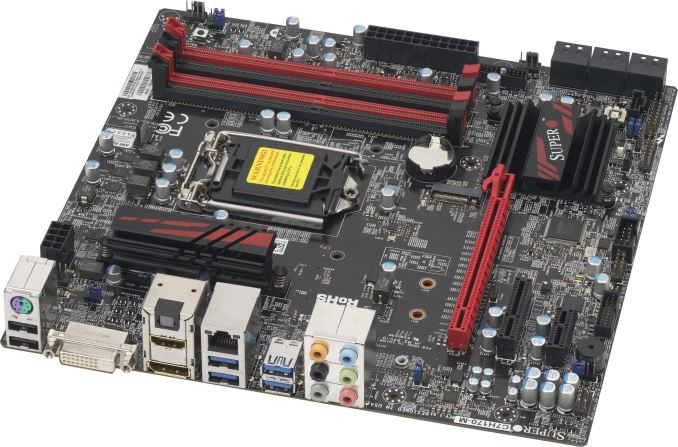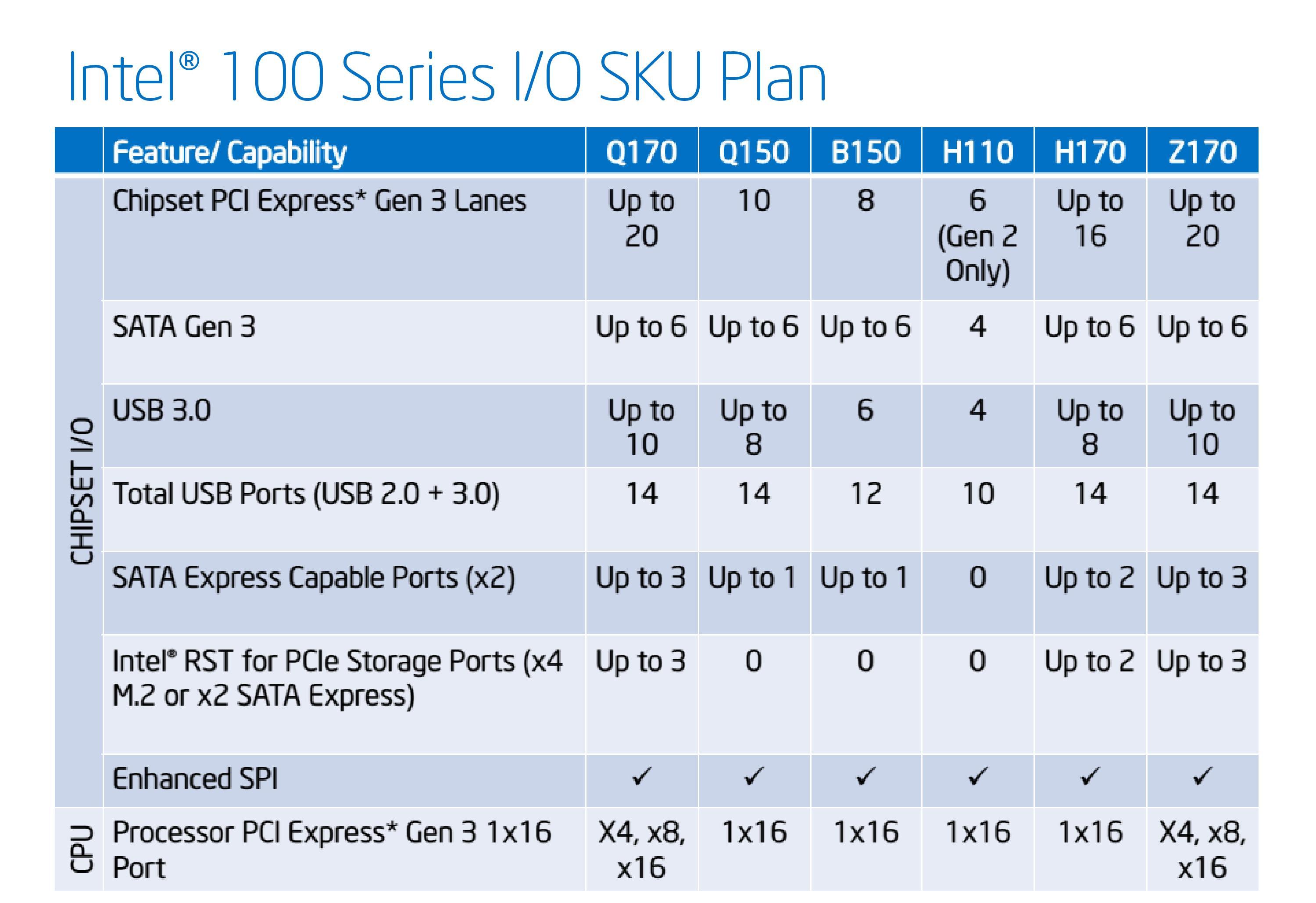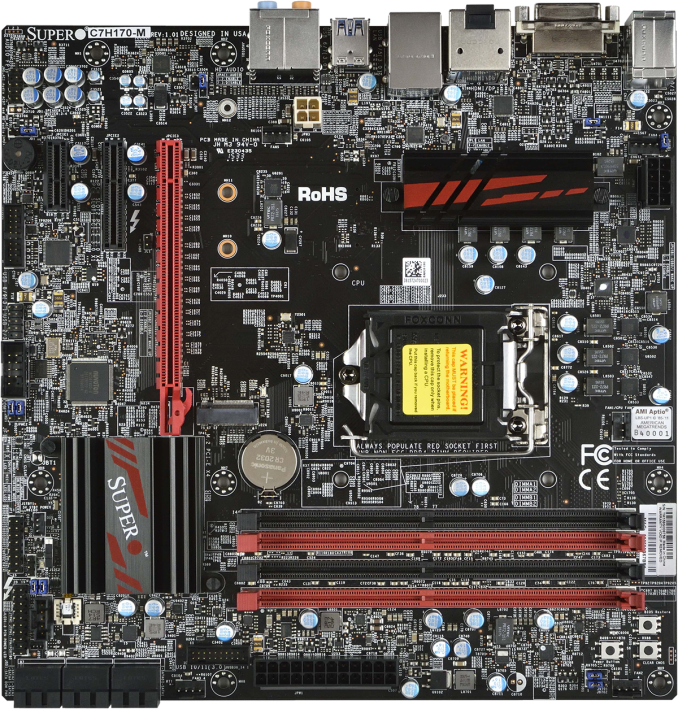Why an Overclockable Core i3 Might Not Exist: The Supermicro C7H170-M and Intel Core i3-6100TE Review
by Ian Cutress on March 17, 2016 10:30 AM EST- Posted in
- CPUs
- Intel
- Motherboards
- Core i3
- Supermicro
- Overclocking
Supermicro Going Consumer
When it comes to consumer grade motherboards, or at least on the enthusiast side, our coverage consists of 90%+ of the top four manufacturers - mostly due to sales figures and reader interest. Every so often we get in a sample from the next tierof vendor, which can throw us for a curveball based on price, software and/or utility. Arguably Supermicro is in this latter crowd, purely in terms of consumer volume, but they have been a primary Intel partner for two decades and make most of their revenue in the enterprise space. Back in Computex 2015, I sat down with one of the CEOs main advisors and we spoke about the consumer motherboard space, and how/if/whether Supermicro should launch into the area. At the time mentioned three points to them:
- The base quality of consumer motherboards is a relatively high bar to match. The four main companies going at it have had multiple generations of learning, updating, fixing and tweaking their design. Customers expect a lot, even at the bottom end of the market.
- The motherboard market is declining in volume. Each manufacturer is redoubling efforts to maintain their sales volume, let alone keeping their market share. This means having engineers, good marketing, and a clear working relationship with customers on all levels, some of which Supermicro may not be familiar with
- Brand presence and technical prowess are the main avenues to get people talking about your product. Having both the correct stack of parts for your customers as well as something new and innovative (either livery or active feature) is how users will understand your parts, and simple gimmicks are easy to see through.
At the time, Supermicro were quietly confident. They have large technical teams, albeit server based, and a large number of enterprise customers that would appreciate the server touch at a consumer grade sale. However, I would argue that from my perspective, 2014 and 2015 were relatively dull from Supermicro. We technically had the Z87 overclocking motherboard in for review, for example, but I read several reviews where the BIOS needed a lot of work, the software was non-existent, and enthusiasts wanting to push the boat were going nowhere.
We never got around to reviewing the motherboard, due to time constraints with other reviews, but Supermicro was willing to listen to my feedback last year on the state of the industry. They have since moved to selling motherboards through the regular retail channels to get a semblance of market share, and are also trying to build a brand around the SuperO name, which has seen several motherboards launched for Skylake including this green one we reported on late last year. But by some swift engineering, Supermicro managed to be at the center of one of the most interesting overclocking stories in a number of years.
The OC story started with the motherboard we are reviewing in this piece, the C7H170-M. If you read the previous page, we go through the trials and tribulations of how base frequency over clocking on Intel non-K processors is fundamentally encouraged by the base CPU design but was locked by default, then enabled if certain hardware changes were made, then locked again by firmware, but might be re-enabled in certain circumstances. Throughout the debacle, Supermicro has held firm and not removed any product from the market, but is also being tight lipped on their updates.
Supermicro C7H170-M Overview
At $128 as the current retail price over at Newegg, the Supermicro C7H170-M is the cheapest motherboard we have tested on the Skylake platform so far, but also uses the cheaper H series chipset in a microATX sized motherboard. The H170 chipset is the first step down from the high end Z170, and as such comes with a few more restrictions. H series chipsets, for example, are designed for systems that incorporate a single discrete graphics card (which fundamentally covers most PC users), and have a lower number of high speed ports for PCIe based RAID storage or extra controllers connected to the chipset.
As for the motherboard, it's clear that Supermicro are taking things like livery a bit more seriously. The board is busy - lots of contact pads, pin-connection switches and new sizes/combinations of push buttons. This is mixed with the new color scheme, which can be a bit off putting. But for $128, there are a number of points both positive and negative on the bill of materials.
At this price point I was glad to see an Intel I219-V network controller as well as the high end Realtek ALC 1150 audio code. Typically with a cheaper motherboard, audio and networking are the first to be downgraded but Supermicro has kept them here. We have no USB 3.1 unfortunately, which is atypical from our 100-series coverage so far, but the board has support for all the USB 3.0 ports that the chipset offers. As a server motherboard company we get a trusted platform module header as well as a power switch, but not a two-digit debug display for error codes. At this price point and board size there is a full complement of memory slots, supporting JEDEC speeds up to 16GB per module of DDR4. This is a motherboard that isn't really built for overclocking, despite the nature of this review, so as a result we get a five phase power delivery design using standard server-grade VRMs and chokes.
On the BIOS and software side, it is clear that Supermicro has a lot of work still to do in terms of user experience. They have transitioned from a bland BIOS interface to something graphical, though it is significantly clunky with both mouse speed and the ease of use of the keypad to move into certain sections. There’s also the utility aspect, such as fan controls, which have been reduced the optimal or full-speed only. I would say that the overclocking options, although basic, give an easy way for most people to go and overclock by offering an automatic look-up-table in 5 MHz increments.
The software stack uses monitoring software, oddly through a HTML interface which is probably indicative of how server systems are usually controlled (even though we don’t have an IPMI connection here). That being said, the software tool does provide a lot of information, even though it is not as extensive as what the regular consumer motherboard manufacturers provide.
Performance was a mixed bag in the grand scheme of things, albeit with a few interesting segments above the price band: there’s no Multi-Core Turbo here, the DPC Latency was high and POST times are beyond 30 seconds, but the power consumption between idle and load is decent enough and the audio results put the solution as one of the best we’ve tested so far on Skylake.
At this point, for $128, the C7H170-M comes across as a nice motherboard to have, but only if it comes with the overclocking feature and/or retains its position as the only motherboard capable of non-Z and non-K base frequency overclocking. That’s where the true value lies, mostly because there are other motherboards in this price range that have more features. As it currently stands, base clock overclocking is still listed on retailers as its main feature (3/17), so if it still says that when purchased but is removed at a later date, I would assume it could be returned.
Quick Board Feature Comparison
| Motherboard Comparison | ||
| Supermicro C7H170-M | ||
| Socket | LGA1151 | LGA1151 |
| MSRP at Review | $128 | $230 |
| DRAM | 4 x DDR4 | 4 x DDR4 |
| PCIe Layout | x16 | x8/x8 |
| BIOS Version Tested | v1.0c | 142 |
| MCT Enabled Automatically? | No | Yes |
| USB 3.1 (10 Gbps) | No | ASMedia ASM1142 1 x Type-A 1 x Type-C |
| M.2 Slots | 1 x PCIe 3.0 x4 | 2 x PCIe 3.0 x4 |
| U.2 Ports | No | No |
| Network Controller | 1 x Intel 219-V | 1 x Killer E2400 |
| Audio Controller | Realtek ALC1150 | Realtek ALC1150 |
| HDMI 2.0 | No | No |













62 Comments
View All Comments
Tunrip - Friday, March 18, 2016 - link
I began reading Anandtech long before I actually had a PC, let alone began overclocking.What was that Celeron everyone raved about back in the day? Celeron 200A or something?
I remember Anand used to make reference to it. These overclockable i3s remind me of that. A budget chip that could blow away the higher-performing (and costing) chips of the day when overclocked.
Simpler times... :)
ses1984 - Friday, March 18, 2016 - link
So Why Do We Not See an Overclockable i3 CPU? No competition from AMD.Macpoedel - Saturday, March 19, 2016 - link
Zo SuperMicro seeded you a slow Core i3 that you only got as vast as a regular Core i3. Basically what you showed Here is that a regular Core i3 6100 isn't !much slower than a regular Core i5 6500 but it is over $50 cheaper. Could it have hurt to mention that a Core IE 6100 runs at 3,7GHz?Couldn't you just get the Core i3 6100 yourself or is Anandtech not allowed to buy hardware? I get that you can't just go out and buy a Core i7 5960x or a GTX Titan X, but the company couldn't pay a $100 CPU? Funds can't be that tight. The only conclusion I can make is that you have some deal to only use seeded parts.
Honestly what is the point of this 15 page article if you don't get the relevant parts? Are you yourself satisfied about these results? I think you've done a lot of work completely in vain. It's good that you try to be a little more than just another promotion channel for Intel/SuperMicro/etc but you should have been a little more critical to yourself when reviewing the results and considering the parts you're using.
Macpoedel - Saturday, March 19, 2016 - link
Oops some words got autocorrected to Dutch in the first paragraph, but I guess it's clear what I'm saying, can't edit apparently.stardude82 - Saturday, March 19, 2016 - link
I don't see the value here when you are spending such a premium for a budget board. Just looking at Newegg, there is only a $10 savings going from an i3-6100 with this board to an i5-6500 with a H110 board.lagittaja - Monday, March 21, 2016 - link
What a pointless article. A 15 page long article which is completely pointless.Are you yourself satisfied with your article Ian?
What did this tell us consumers?
That if you take an unobtanium slow arse i3 and OC it, it performs about the same as the regular i3's which are widely available?
Great scott! I did not expect that! Mind blown!
Now run along to the store and grab a 6100/6300/6320 and do proper testing. We want to see that 4.5-5Ghz i3 go head to head against the OC'd i5..
LuxZg - Monday, March 21, 2016 - link
I'd like to say that part about BIOS obviously isn't true, as people have tried and succeeded to revert back to older versions. Example:"Assuming you can get your hands on the OC BIOS it is possible to flash back to the previous version to regain the base clock overclocking ability. Again the microcode isn’t written to the CPU and is kept at the BIOS level so rolling back isn’t a problem.
To confirm this, I updated my Z170 Extreme7+ motherboard to version 2.60 and sure enough the overclock no longer worked. After rolling back to version 2.16 the ability to overclock my non-K processors returned."
source: http://www.hardwareunboxed.com/current-state-of-in...
StrangerGuy - Monday, March 21, 2016 - link
Free lunch is: Abit BH6 + 300A, nForce 2 + unlocked Athlon XP, P35 + <$200 ConroeNot free lunch: Anything today thanks to incredibly restrictive CPU/chipsets lockdowns. With my 4790K already stock at 4.2GHz I'm not going to bother with OC. I'm not even going to mention the absurdity of pairing $100+ mobo just to hack-OC a $100 already at 3.7GHz CPU that would probably get locked down by Intel with a stealth microcode update.
Rob27shred - Tuesday, March 22, 2016 - link
Great read! Definitely gives a very clear explanation of why Intel has denied us a K SKUed i3. I was very excited when I first heard of being able to OC non K SKUed Skylake chips. I have an extra GB Z170XP-SLI mobo & was planning on getting an i3 6XXX to have a little fun with. Now I have to look into it further as I don't want to buy an i3 & not be able to OC it.It's a shame that Intel pulled the rug out from under this so quickly but I from a business point of view you really can't blame them. I got hopes that other ways around Intel's micro code update will be seen though. I heard ASrock released a mobo aimed squarely at getting around the new restrictions.
yhselp - Tuesday, March 22, 2016 - link
Sheeeit! That's the best damn AnandTech article in a long, long time. God bless you, Ian! Fantastic. Quintessential AnandTech! I'm thirsty for more.Maybe a super in-depth article on the effects of faster RAM on modern games? DDR4@3200 seems essential for a new build nowadays, and a DDR3@2133/2400 upgrade could potentially be a great upgrade for gamers stuck on 1333/1600. 16GB a must for Windows 10 gaming? Maybe an article on GPU overclocking, AMD GPUs driver overhead, achieving minimum frame-rates, etc.